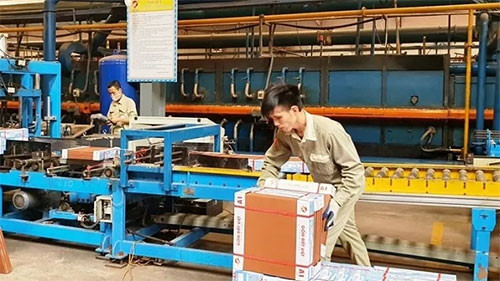 |
| Vietnam is showing stronger resilience than most comparable economies, and the economy’s outlook over the medium and long term remains positive amid COVID-19. (Photo: NDO/Quang Tho) |
Lower domestic consumption and weak global demand caused by COVID-19 have hurt Vietnam’s economy more than expected. But economic growth will be resilient in 2020, in large part due to the government’s success in controlling the spread of COVID-19, said ADB Country Director for Vietnam Andrew Jeffries.
Economic growth will be supported by the country’s macroeconomic stability, increased public spending, and ongoing reforms to improve the business environment, the lender’s official added.
The Asian Development Outlook (ADO) 2020 Update, ADB’s annual flagship economic publication, says Vietnam’s economy will benefit from the continued diversion of production from China to Vietnam, a recovery in the Chinese economy, and the implementation of the free trade agreement with the European Union. Slower-than-normal growth would keep inflation subdued at 3.3% in 2020 and 3.5% in 2021.
Vietnam’s economic outlook over the medium and long term remains positive. Vietnam’s participation in a large number of bilateral and multilateral trade agreements will help the country’s economic rebound. Vietnam will also likely benefit from a current shifting of supply chains to low-cost countries.
Significant risks remain. A prolonged global COVID-19 pandemic remains the biggest risk to Vietnam’s growth outlook this and next year. Another threat is global trade tensions, which lead to rising trade protection and financial risk that could be exacerbated by a prolonged pandemic, the report says.
Vietnam’s economic outlook in the short term is difficult, with the global economic downturn and domestic weakness proving worse than expected. However, the country is showing stronger resilience than most comparable economies, and the economy’s outlook over the medium and long term remains positive. Economic fundamentals have not been impaired, and Vietnam looks likely to benefit from current trends in global patterns of trade, investment, and production.
On the continental level, economies across developing Asia will contract this year for the first time in nearly six decades but recovery will resume next year, as the region starts to emerge from the economic devastation caused by COVID-19, according to the ADB report.
The ADB forecasts -0.7% gross domestic product (GDP) growth for developing Asia this year, marking its first negative economic growth since the early 1960s. Growth will rally to 6.8% in 2021, in part because growth will be measured relative to a weak 2020.
This will still leave next year’s output below pre-COVID-19 projections, suggesting an “L”-shaped rather than a “V”-shaped recovery. About three-quarters of the region’s economies are expected to post negative growth in 2020.
Subregions of developing Asia are expected to post negative growth this year, except East Asia which is forecast to expand by 1.3% and recover strongly to 7.0% in 2021. Some economies heavily reliant on trade and tourism, particularly in the Pacific and South Asia, face double-digit contractions this year. Forecasts suggest that most of developing Asia will recover next year, except for some economies in the Pacific including the Cook Islands, the Federated States of Micronesia, the Marshall Islands, Palau, Samoa, and Tonga.
The inflation forecast for developing Asia has been revised downwards to 2.9% this year from the 3.2% forecast in April, due to continued low oil prices and weak demand. Inflation in 2021 is expected to ease further to 2.3%.
Source:NDO




















.jpg)




.jpeg)

.jpeg)


.jpeg)

